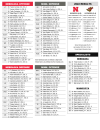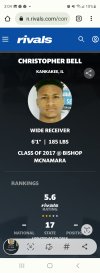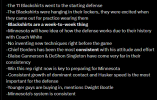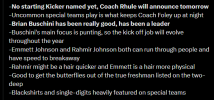Install the app
How to install the app on iOS
Follow along with the video below to see how to install our site as a web app on your home screen.
Note: This feature may not be available in some browsers.
-
Welcome to The Platinum Board! We are a Nebraska Cornhuskers news source and community. Please click "Log In" or "Register" above to gain access to the forums.
You are using an out of date browser. It may not display this or other websites correctly.
You should upgrade or use an alternative browser.
You should upgrade or use an alternative browser.
Minnesota Game Week Thread
- Thread starter vailhusker
- Start date
holy fuck it feels like autman-bell has been a goopher for 17 years
Feels like Minnesota's program has perfected the get old and stay old mantra along the offensive and defensive lines
Think he's in his 6th year.holy fuck it feels like autman-bell has been a goopher for 17 years
He wants to beat Tanner Morgan's record.holy fuck it feels like autman-bell has been a goopher for 17 years
McKewon: 7 stats, 7 players and 5 questions as Matt Rhule tries to resurrect Nebraska football
- Sam McKewon - OWH
- Updated 5 hrs ago
We’ll track the data, players and questions as the season progresses. Look for NU to run a pro-style spread with lots of formations, shifts, motions (and huddles). Look for the defense to unload the kitchen sink.
Clearly the defensive personnel — with seven of the nine single-digit jerseys — is ahead of the offense. That makes sense.
The culture, previously built by former defensive coordinator Erik Chinander and his staff, is better on that side of the ball, and coordinator Tony White’s approach has resonated with new and returning players. The defense relies on Luke Reimer, Nick Henrich and Isaac Gifford.
Nebraska’s offense is onto its third starting quarterback, third offensive coordinator and third lead wideout in as many years.
I can’t tell you exactly what wrinkles White has in store, but I can imagine the speed with which the defense will play.
I have a decent idea of what offensive coordinator Marcus Satterfield will run but lack clarity on how well it will go.
Head coach Matt Rhule oversees the whole operation. He’s coached both offense and defense in his career, and installed his detail-oriented, immersive culture as much as a coach could in nine months.
Will it hold? A 3-1 start — which is possible — would help, but the season’s success will ultimately rest on what the Huskers do in the four games after a mid-October bye week when they host Northwestern and Purdue, head to Michigan State and host Maryland in a four-week stretch. If you want to know how far NU has come under Rhule, you’ll see it there. Good teams play well in the back half of the season.
There are six games before that — including a trip to Colorado and headliner home game against Michigan. Here’s what to watch right now — and later on:
Quarterback carries per game: You watch this number because it’s both indicative — of how Nebraska is doing running the ball with its backs — and predictive of what will happen with fumbles. There’s a relationship between quarterback carries and fumbles — of the 45 players, last season, who had at least five fumbles, 42 of them were quarterbacks. Not all of them were runners — one, with seven fumbles, was South Carolina passer Spencer Rattler — but many of them were of the dual-threat variety. NU quarterback Jeff Sims in 2020 led the nation with 10 fumbles.
Even if Sims has cleaned up his ball security — Adrian Martinez got better in 2021 compared to previous years — he’s going to fumble if he’s asked to run the ball 12-to-15 times per game.
Now — Sims is a great runner, and maybe he should run that often if that’s what NU needs to get in scoring range. Four drives without Sims runs — that also result in zero points — is not preferable to four drives worth 14 points and a lost fumble.
That’s the gamble. Quarterback runs are risk/reward propositions, and the Gophers are susceptible to them, as Martinez had 125 rushing yards in 2018 and 96 in 2020.
My hunch is Nebraska will try to run the ball with its backs, especially against bend-don’t-break defenses that allow NU to churn clock. But much like a defense eventually resorts to a Cover Zero scheme to take easy throws, the Huskers didn’t bring Sims to Lincoln so he could stand in the pocket 45 times. They could have kept Casey Thompson for that.
Combined targets per game for tight ends and running backs: Nebraska’s wide receivers will be led by Billy Kemp, the team’s most seasoned, smartest and most dependable receiver.
Presuming he stays healthy, Kemp
might get 110 targets this year. Because he’s 5-foot-9 — and not, like Trey Palmer, 6-0 — he may not flash open on seam routes like Palmer and Samori Toure did.
Eight targets per game — similar to Wan’Dale Robinson in 2020 — seems about right. That leaves 15, 20, 25 targets per game for Sims to distribute elsewhere. How many go to the tight ends? In 2021, 5.91 targets per game went toward Austin Allen and Co. And how many go to the running backs? In 2022, that figure — 2.33 per game — was anemic. Look for that figure to double, this year, under Satterfield.
Why? Because NU lacks proven downfield burners at wideout. Alex Bullock could be the next Brandon Reilly, but he’ll have to prove that. Marcus Washington missed parts of training camp. And Kemp, while excellent, won’t be used the way Palmer was. Nebraska’s pass game will have to be more diverse — screens, rollouts, tight ends in the flat — absent an elite corps of receivers.
Tackles for loss per game: The 3-3-5 defense is an aggressive scheme that mixes fronts and blitzes, utilizing quicker, somewhat smaller players to execute that scheme so as to overwhelm the offensive line. You don’t run the 3-3-5 to box in the middle of the ring. You run it to go for knockouts. You run it to put an offense behind the chains on early downs to create passing situations. You run it to free up linebackers and safeties to make the plays.
Tackles for loss — and, to a lesser degree, sacks — are designed to be a byproduct of the scheme. OK, zero-yard gains, too. As Rhule and defensive coordinator Tony White have said, the scheme will be sound. But it’ll play with a leading edge — if it can.
On a per-game average, 7.0 or above is good. Between 20 and 30 teams achieve that every year; last year Penn State had eight per game. (So did Oklahoma, and that defense was…woof.) But it’s also good to look at tackles for loss relative to plays faced.
So last season, Cockeye averaged 6.62 TFLs per game — out of 67.9 plays per game. Ohio State averaged 6.62 per game, as well — against 62.1 plays per game. Advantage: Buckeyes.
In the last six years, NU has ranked the Big Ten’s top half just once — in 2020, when the Huskers had 6.63 tackles for loss per game while facing 70.8 plays per game. Last year, Nebraska had 5.0 TFLs per game while facing 75.6 plays per game. Not. Good.
Takeaways per game: Ideally, you’d love this number to be 2.0 or better per game. Between 10 and 25 teams achieve that number each year; the Huskers last did so in, you guessed it, 2009. Illinois had 2.3 in 2022. Cockeye had 2.2 in 2021. Since 2017, the Huskers’ best number in that category was 1.75 in 2019, when they had 21 takeaways in 12 games, buoyed by five against South Alabama and four against Maryland.
While tackles for loss is probably a better gauge of whether Tony White’s defense works as designed, takeaways can be a byproduct of putting teams behind the sticks and quarterbacks under duress.
But here’s proof of how much takeaways matter: Since joining the Big Ten, Nebraska is 20-4 when causing three or more turnovers. This includes the 2014 and 2022 wins over Cockeye, the 2012 win over Michigan and the 2014 win over Miami. Takeaways matter.
Field goal attempts beyond 40 yards: You’ll learn a lot about what Nebraska thinks of its scoring strategy by gauging this figure. Rhule talks about field goal “make range” — which is different from the green line you see on your screen, designed to determine the extent of a kicker’s potential range.
What teams willingly attempt to make? That’s the real range. Alex Henery attempted 13 field goals of 40 yards or longer in 2009. Nebraska attempted three of those in 2022. The gap can be partly explained by shifting sentiment around the value of field goals when a fourth down is convertible. It can be explained, too, by the uselessness of three points when the deficit is three touchdowns. But it speaks to kicker range, too.
And it’s possible — even likely — Rhule has a healthier appreciation for field goals that Scott Frost did. Rhule coaches games in a manner that acknowledges the value. Frost cut his teeth under Chip Kelly, who had little time for kickers at Oregon, and Mark Helfrich, who lost a game at Nebraska going for — and failing to convert — too many two-point conversions.
Overall return yards: Nebraska’s gotta get better here. While special teams coordinator Ed Foley can only do so much about the effectiveness of his kickers and punter — you put the wedge in their hands and ask them to put it on the green — he can help create a competent return group.
Nebraska averaged 17.08 yards per kickoff return in 2022. Yuck — 13th in the Big Ten. In 2021, it was worse — 15.58 yards per return. The Huskers haven’t been above 20 yards per kickoff return since 2017, when JD Spielman returned a kickoff for a score.
Punt return is a little bit different — Big Ten punters are so good that it can be hard to return three punts per game — but Kemp is a gifted tracker of the ball, so perhaps he can bust one. Rhule said he wants his team to block as many punts as possible, which seems like a good strategy in a league where, no matter how well-conceived a punt return might be, punters can bomb a 57-yarder to negate the scheme. Aim for an average of 21 per kick return, and 200 overall punt return yards, which would include any returns off of blocks.
Yards per point differential: The more yards it takes a team to score a single point, the less efficient it is at doing so. The opposite is true for an opponent — you want them to take, for example, 125 yards to score a touchdown.
A team that has 300 total yards — and scored 30 points — is, well, like Cockeye. There’s probably a defensive touchdown in there. Or a punt return for a score. Or a couple safeties. Ten yards per point is terrific — and unsustainable.
The best teams in the country at this stat — Ohio State, Michigan, Alabama and Tennessee in 2022 — usually come in around 11.0. Northwestern, meanwhile, was 25.9 last year. That means, last year, it took the Wildcats nearly 400 yards to score 14 points. (Except against Nebraska!)
To determine differential, you subtract a team’s yards-per-point — which, ideally, should be low — from the opponent’s yards-per-point figure, which, ideally, should be high.
The 2009 Nebraska team had a differential of 13.3 because it took Husker foes 26.1 yards to score a point. Cockeye’s 2022 differential was +6.1. The 2019 Baylor team — Rhule’s best — had a differential of +5.3. The 2016 Temple team — which won the American Athletic Conference title — had a +1.6 differential.
The 2022 Husker squad had a -1 differential. NU hasn’t had a positive differential since 2016 – its last winning season.
Seven players to watch
Tight end Thomas Fidone: I mean, of course, right? Fidone probably won’t be a complete tight end in the first month. Can he get a defense to pause and note his presence on the field? Can he beat the brakes off linebackers who try to cover him? Tight ends make their own plays, but they also shape a defense’s response. Opponents who don’t adjust — 1994 Colorado — suffer the consequences.
Running back Rahmir Johnson: Is Nebraska serious about using his straight-line speed, toughness and route-running skills? We’ll see. NU’s previous offensive staff blew that.
Linebackers MJ Sherman and Chief Borders: High-profile SEC transfers who need to be playmakers right away. More than Ochaun Mathis was for 80% of last season. Sherman and Borders each have leadership personalities — they’ll be good vocal leaders if they produce. If. Sherman, in particular, can help his draft stock.
Punter Brian Buschini: A jump from good to great would be ideal. You might barely notice it — but an extra eight-to-10 yards matters in field position. Buschini has designs on playing in the NFL; he can prove it in 2023.
The right side of NU’s offensive line: Can the Huskers run behind Noure Nouili and Bryce Benhart? Signs say yes, especially with Nouili. Most offenses are “right-handed;” that is, they run more to the right than to the left, and, when they pull, they pull a right guard to the left to set up a power play or a bootleg. My money says Nouili is the team’s best lineman. We’ll see.
Safety Omar Brown: Splash play guy who, according to Rhule, needs to be more consistent play to play. That describes Tommi Hill, too. NU’s secondary needs to make more big plays than it gives up, and every one of those defensive backs need to tackle behind an aggressive defense. When the offense guesses right — be ready to wrap up.
Five questions
Do Nebraska coaches and players appreciate how big that Colorado game really is to the Big Red Layperson? In terms of Big Ten standings, it technically matters much less than the Minnesota game. In the hearts of many Husker fans, it’ll matter much more. A loss at CU wrecked the 2019 season. NU — and Scott Frost — never quite recovered. Colorado and Missouri strike a certain contemptuous nerve in Nebraska fans.
You can bet CU matters to Rhule’s boss, Athletic Director Turd Alberts. Ask him about the Huskers-Buffs series during his five years on campus as a player.
Will the freshmen grow up or wear down?
Both could happen. As the youngest players on the team better understand what’s asked of them on and off the field, they also can hit a wall. College football asks so much of young men as athletes and students. As NU moves into October and November, it’ll be interesting to see if guys like Cam Lenhardt and Malachi Coleman lean into the moment or have to battle through the grind.
Can Rhule improve Nebraska’s red zone strategy? Effectiveness and efficiency is one thing; he can’t control the execution. Are the ideas better than they often were under Frost? It will help, of course, that Sims knows how to take a snap from under center.
Who, if anyone, among the Husker defenders can whip an offensive lineman for a sack? NU’s best pass rushers in 2022 — Garrett Nelson, Mathis and Caleb Tannor — are gone. And they weren’t exactly Bruce Smith. NU needs a pleasant surprise in its pass rush. A Randy Gregory or Eric Martin.
Is Marcus Satterfield more Shawn Watson, Tim Beck, Danny Langsdorf, Troy Walters, Matt Lubick or Mark Whipple? Of that six, Beck performed the best, Whipple did the poorest and Langsdorf was the boom/bust guy who often manage to call the wrong sideways pass at the wrong time. My hunch: Satterfield’s approach is closest to Watson, who called plays during the early years of the Bo Pelini era with some effectiveness, but also had a tendency to get too elaborate in his use of players and formations.
In the "what the B1G is saying" thread, Minny fans were saying their O-line should be licking their chops because of how small our d-line is. Our d-line starters are bigger than theirs. lol
Last edited:
What is his phd in
He has 4 majors. Pottery, Businesslike sciences, theater and elementary education.What is his phd in
Gimme a chic fil a and Amigos menu and I'll live at memorial
A high schools wet dream of a teacher to salary at 38k a yearHe has 4 majors. Pottery, Businesslike sciences, theater and elementary education.
Gimme a chic fil a and Amigos menu and I'll live at memorial
Real slap in the face to the Nebraska beef farmers.
Eastern Nebraska gonna Eastern NebraskaReal slap in the face to the Nebraska beef farmers.
Similar threads
- Replies
- 161
- Views
- 8K
- Poll
- Replies
- 99
- Views
- 4K




